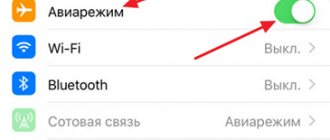A smartphone heating up while charging is not yet a reason to contact service. You can identify and eliminate the cause of heating at home.
Phones running on MediaTek processors are more susceptible to heating. As a rule, devices with Snapdragon chips heat up somewhat less.
First of all, you need to make sure that the smartphone is not charging in a warm place - there should be no heaters or direct sunlight nearby. Now you can determine how hot the gadget is. For a modern phone, heating within 35-40 degrees is already considered the norm. Having crossed the threshold of 45 degrees, the smartphone literally burns the user’s hands, so working with it ceases to be comfortable. You can find out the temperature of your phone using special applications that are available for download on Google Play.
There are mainly three elements that are subject to heat:
- display;
- battery;
- CPU.
The most dangerous thing for the user is the heating of the battery. If the temperature reaches high temperatures, there is a danger of the battery swelling and exploding. This was written about a lot last year after the release of the Samsung Galaxy Note 7. Excessive heating of the display or processor should be taken as a signal that the smartphone is not working correctly.
Charger
Manufacturers recommend charging smartphones only with original chargers - they guarantee compatibility and the current required for a particular phone. Often it is non-original adapters and cables that cause the gadget to overheat while charging. Using a one-amp power supply in most cases solves the issue of heating the smartphone, but charging time almost doubles.
Why does my phone get hot? Reasons for smartphone heating
The phone heats up if some parts of the hardware work excessively: processor, display, battery. The normal “operating” temperature of a smartphone is from 0 to 37 degrees Celsius. If the smartphone heats up to 50 degrees, then this is a reason to worry and the first thing to do is identify the place and part where the phone is heating up:
- Battery
If your phone's lid gets hot, your battery is most likely overheated. If you see the cover bulging, then the battery should be replaced urgently, because it may explode.
The battery is made of lithium. This metal has a low melting point and if it is often in a heated state, then your phone may quickly discharge and then stop working altogether.
The maximum temperature at which the battery can operate is 60 degrees, but this will still affect the capacity.
The battery may overheat due to long use. The first signs that you need to change the battery:
- Rapid discharge and severe overheating of the smartphone.
- The battery is over a year and a half old.
- Charger
If the bottom of your phone gets hot, you most likely have a problem with your charger. This may happen due to the use of a non-original charger of poor quality.
Try to use only certified accessories. Use your phone as little as possible when it's not charging.
While charging, try not to play games, talk on the phone or download heavy files and applications; it is better to wait until the phone is charged. If the voltage is high, one of the microcircuits may burn out; in the worst case, the phone itself may catch fire.
Also, do not use the charger when there is a sudden change in temperature, for example when you go from cold to warm. Let the phone adjust to the room temperature. Otherwise, condensation will form, which will cause the contacts to oxidize and break the battery.
- Screen
If the screen heats up, then most likely you have been running the display at high brightness for a long time. Put your phone down for 15-20 minutes, close applications and lower the brightness. Also, the display can become very hot during a conversation when you hold the handset to your ear.
How to find out the temperature of a smartphone?
- If you have an Android operating system, we recommend downloading the AIDA64 application, thanks to which you will find out all the information about the current state of your device, its software, and of course information about the temperature. If you are an Apple owner, you don't need to download anything, you have the Battery Health app that will show your battery health. You just need to update your software to iOS3. However, this application will not be able to show the temperature.
- Monitor the frequency and degree of heating of the phone.
Reasons for phone overheating
There are problematic reasons for the phone to overheat, and there are standard ones that every smartphone owner encounters at least once and do not pose a big threat. Let's understand in what cases and why the phone heats up?
Standard reasons:
- Long conversations on the phone
Every phone has a communication transmitter and receiver. During a long conversation, these parts have to constantly transmit information, as a result of which both the contacts and the smartphone itself heat up. And if the connection is poor, then the transmitter needs as much power as possible to pick up the signal. Then you shouldn’t be surprised that a smartphone is like a hot iron.
When we talk for a long time, the display also heats up, which we hold for a long time near our face and heat with the heat of our body.
We are confident that long conversations on the phone are not particularly dangerous and will not cause contacts to burn out or the processor to crash. But we still advise you to put the phone down after a long conversation or at least switch to a headset.
- Long game on the phone
We have already said that smartphones have now been able to replace computers in many ways, including in playing games. A wide variety of applications is a source of income for both Apple and Android.
Not everyone has the means to buy expensive gaming computers and accessories, if you can play the same “tanks” and strategies on your phone, even at home, even in a taxi, even at work.
Stunning graphics leave neither children nor adults indifferent. This is why most smartphones have fairly powerful processors that generate more heat during operation.
The higher the intensity of the game and the cooler the graphics, the more thermal energy the processor emits.
“Don’t drive” the phone for too long, take breaks, allowing the smartphone to “rest”. Also, calculate the number and size of applications when installing games on your phone at the same time, download no more than 1-2 programs or games at the same time. And also do not play during prolonged exposure to the sun, in a sauna or hot tub.
- Watching video content for a long time
When watching movies, TV series on Netflix, videos on YouTube, Tik-Tok, and even stories on Instagram (don’t lie, you know, it’s very addictive), the processor loads video data for a long time and keeps the screen active, just like when playing games.
Normally, the phone should not overheat in such situations, but if it gets hotter, this is a reason to worry. Disable all applications while browsing, turn off Wi-Fi, Internet and Bluetooth. Give your phone time to rest.
- Always-on data transfer
If you constantly (hopefully not simultaneously) have Wi-Fi, GPS, LTE or 3G (Internet) and Bluetooth turned on, then it’s funny to ask the question “why is the phone heating up?” When these systems operate, data transmitters operate uninterruptedly, the processor does not stop for a minute, and the battery actively continues to waste charge.
Our advice is to use data transfer wisely. There is free Internet, then turn off data transfer and vice versa. GPS is also not needed if you are not currently using a navigator. Turn off all data transmission systems on the plane, because... The transmitters continue to function and search for a signal, wasting energy and heating the phone, even if there is no connection.
- Unnecessary settings
We understand that everyone sets the settings they need. But if the question arises, “Why does the phone heat up?”, then first of all, we advise you to pay attention to the settings. Themes, widgets, animated wallpapers, charging screensavers - all this is certainly extraordinary.
But if problems begin with the processor, then it is better to reduce its load by abandoning such additional settings or at least reducing their number and screen brightness.
- Case
Oddly enough, but true - a thick case can cause the phone to overheat. Of course, it does not overheat the phone itself, but it retains heat. No, this does not mean at all that now you need to turn away from him completely.
Our advice is to remove the case when playing games, watching movies or TV shows, actively using your smartphone for a long time, and, if possible, when talking. Try to “change” your phone into a lighter version - a silicone case. They cool the smartphone faster.
By the way, you can choose cool and high-quality cases for your smartphone in our online store catalog
. The 100 Friends store always regularly updates its assortment. Here you can find a smartphone case for every taste. We are responsible for quality!
- External environment
The sun can cause heatstroke not only in humans, but also in smartphones. When on the beach, in direct sunlight, do not leave your phone without a shadow, because the screen may be in a bathhouse or in a car, do not leave the phone without a shadow. Spots may appear on the phone because... the matrix will burn out, and the microcircuits may also begin to be damaged.
Hot air can also cause overheating. Do not leave your smartphone in a stuffy car, in a bathhouse or in a pocket in hot conditions. And even more so, do not download large files at such moments, do not have long conversations, do not play games or watch videos for a long time. This will lead to battery failure and damage to the chips.
- Application updates
Why are updates needed? And why does the phone heat up quickly? Developers prompt users to update games and applications most often when an error occurs.
Programs send incorrect requests, and the smartphone, trying to deal with them, spends a lot of energy and wears out the processor. So update your apps and read reviews. The fewer applications running (especially those with errors), the less wear on the processor and battery.
- Software
What does software have to do with it? And why does the phone heat up?
Many users do not like to update software because... sometimes this causes an error and the battery starts using more power after the update. This can be seen by the quickly draining battery.
In this situation, we advise you to save all data in a backup copy or on a disk, reset the settings to factory settings, restore the data and wait for the developers to release a new software update with bugs fixed.
- operating system
The “OS” tends to become cluttered: shortcuts to deleted applications, unnecessary data, backup copies. This “garbage” slows down the operation of the smartphone, as a result of which it takes longer to search for the necessary information, takes longer to load and spends more effort on processes.
This is especially true for Android-based systems.
The recommendations will be the same as in the previous paragraph: we create backup copies of all necessary information, reset the phone to factory settings and restore the necessary data, and the unnecessary data will be automatically deleted.
Why the phone heats up - problematic reasons
- Virus infection
Malicious programs rewrite application code and operating system software. They can open applications in the background to steal logins and passwords.
Viruses reflash the code of a particular program and a higher load begins to be placed on the processor and battery. So it starts to wear out and the phone starts to overheat.
Be careful! Many such virus programs are disguised in the Google Store. There are known cases where even the battery swelled due to viruses just two days after the smartphone was infected.
In this case, we recommend installing a good antivirus and disinfecting the phone, or, in extreme cases, resetting it to factory settings.
- Parts breakdown
If the reasons listed above are not found, then the reason why the phone heats up may be a factory defect or a breakdown of any part of the smartphone.
In this case, you need to contact a service center, where they will inspect your device and identify the cause of the smartphone overheating.
The answer to the question “why does the phone heat up” will most likely be a breakdown of the battery or power socket as a result of an impact, or it may also be due to oxidation of the contacts due to water getting inside the smartphone.
Errors and malfunctions in the system
Both built-in and user-downloaded software may sooner or later begin to work incorrectly. Software errors can cause your phone to heat up while charging. In this case, removing suspicious programs, flashing the smartphone or updating the software will help.
If the device heating problem cannot be resolved, you must contact an authorized service center. The gadget may need hardware repair.
( 8 ratings, average: 4.63 out of 5)
What temperature is considered normal and how to determine it
It is incorrect to talk about a clear boundary between case temperature between “normal” and “abnormal”. It is unlikely that this figure is even indicated in the design documentation, not to mention the publicly available operating instructions for the smartphone. A deviation from the usual sensations, when the phone behaves unusually during normal actions, should alert you. If the user's hand feels unusually hot, this should be noted.
For those who like clear boundaries, you can pay attention to the limit of 50 degrees C. When this threshold is reached, the degradation of the lithium battery sharply accelerates and the elements of the display matrix begin to fail. This temperature gives an unpleasant sensation, although you can still hold the phone in your hand. You can accurately measure the heating level with a thermometer or, if a pyrometer or thermal imager is available, in a non-contact manner. You can use a thermal imager – an attachment to your smartphone. At the same time, it will help localize the heating area.
Monitoring the distribution of the temperature field using a thermal imager.
But you can determine the temperature programmatically. Owners of Apple gadgets have a built-in utility for this. Android phone users can download and install the AIDA64 application.
Screenshot of the AIDA application menu for Android.
In the menu you need to select the “Temperature” section. In it you can see the heating level from all sensors installed in a specific smartphone model, including the temperature of the battery, backlight, cameras, etc.
Temperature from Xiaomi Mi8 phone sensors.
Article on the topic: Checking the battery status of a phone on Android OS
OS problems
Why does my phone get so hot? The problem may lie in the device's operating system:
- many actions on the smartphone are recorded and stored in the cache;
- garbage from deleted applications remains and accumulates;
- The system stores copies of photos and videos.
All this loads the RAM. Sometimes rebooting the device helps clear the RAM. If this does not solve the problem, you will have to perform a factory reset. So get rid of all unnecessary garbage.
Before performing a rollback, be sure to save contacts and other important data in a notebook. We recommend creating a copy on cloud storage.
Background applications
Another reason why your phone gets hot is running background applications. The smartphone may not be used, and its temperature rises for no apparent reason.
A modern mobile device lives on its own. It performs many operations every second. Due to enabled background applications, the number of processes increases.
If you notice that your phone is getting very hot, take into account the following recommendations:
- Clean your device regularly with special applications (for example, Clean Master).
- Don't leave tabs open in your browser.
- Quit applications completely, not just hide them (if you minimize them, they go into the background and clog up your RAM).











